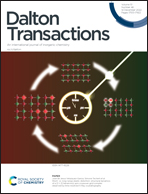A Ru(ii)-arene-ferrocene complex with promising antibacterial activity†
Abstract
The evolution of high virulence bacterial strains has necessitated the development of novel therapeutic agents to treat resistant infections. Metal-based therapeutics represent a promising avenue for advancement, given their structural variability and unique modes of action relative to classical organic molecules. One strategy that has seen marked success is the incorporation of ferrocene into the framework of established antibacterial agents, while ruthenium-based complexes have also shown promise as bioactive compounds. This work focused on the preparation of novel ruthenium(II)-arene complexes containing Schiff base ligands with an attached ferrocene, and evaluation of their antibacterial activity. Structure–activity relationships identified the importance of having a phenyl group between the Schiff base imine and the appended ferrocene. This complex, C2, showed prominent activity against several clinically relevant bacterial strains, including a minimum inhibitory concentration of 16 μg mL−1 for methicillin-resistant Staphylococcus aureus (MSRA). Overall, the results of this study represent a promising new lead for future development of novel antibacterial agents.



 Please wait while we load your content...
Please wait while we load your content...